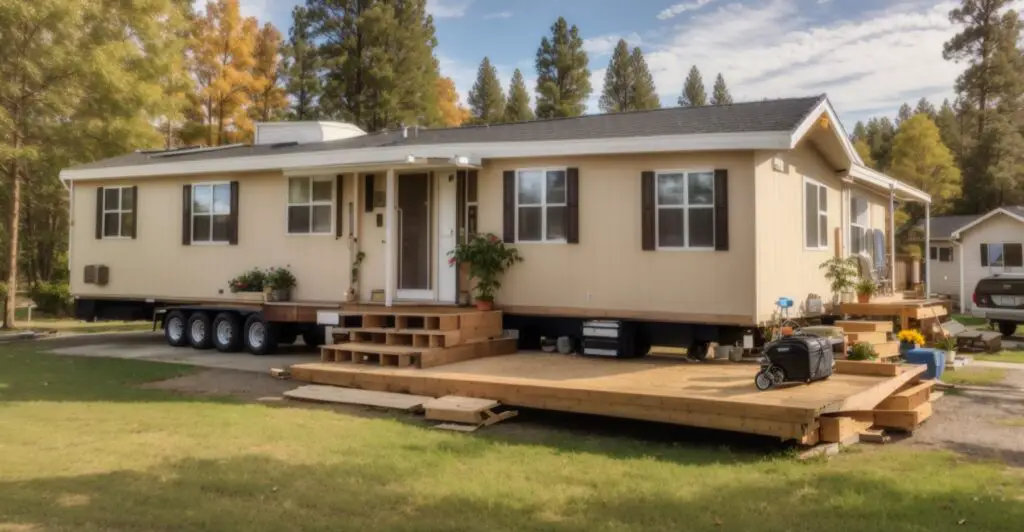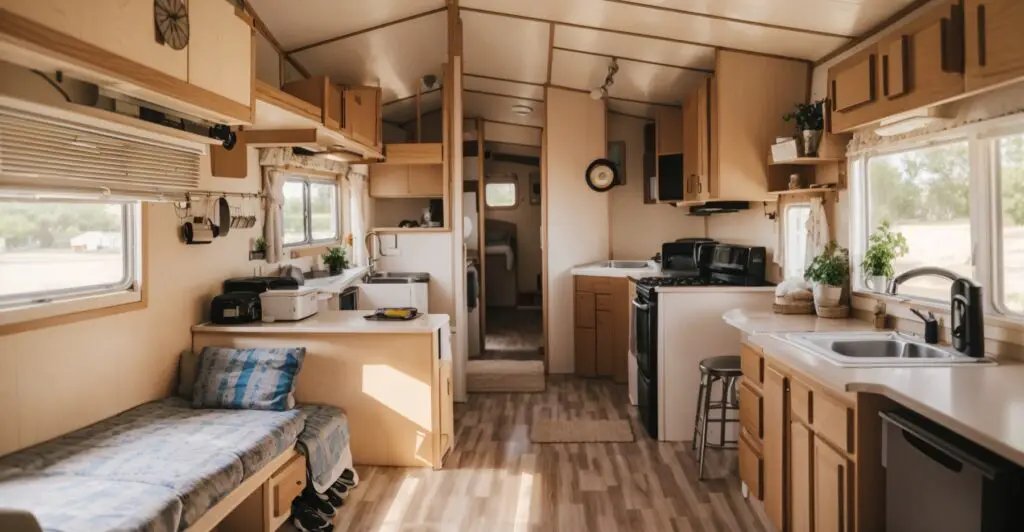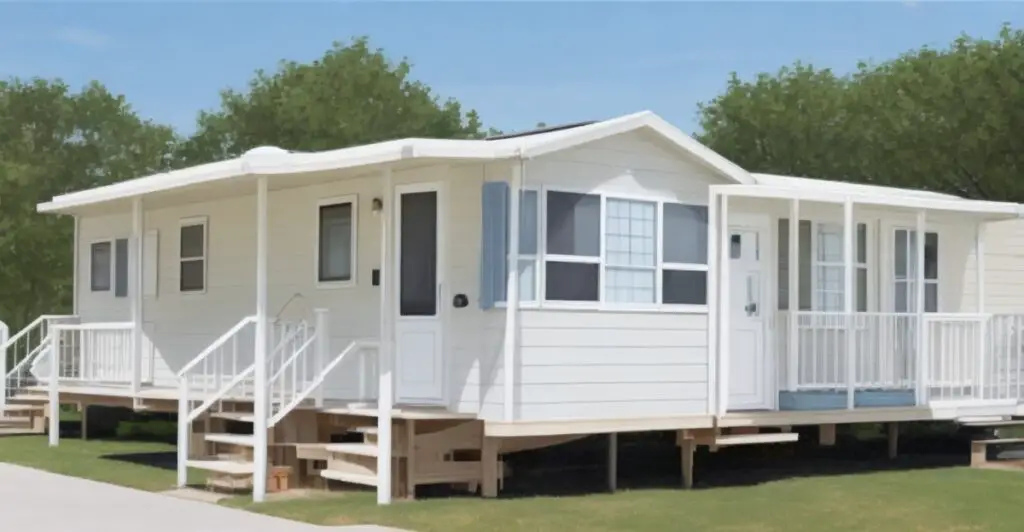Moving a mobile home involves various expenses that can add up depending on several factors. These factors include the distance of the move, the size and weight of the mobile home, the complexity of the route, and additional services required during the process. “How much does it cost to move a mobile home?” can range from a few thousand dollars to a substantial sum, and it’s essential to have a clear understanding of the various components that contribute to these costs. By exploring the key cost factors and potential ways to mitigate expenses, individuals can make informed decisions when planning to relocate their mobile homes.
What exactly is a mobile home

A mobile home is a type of prefabricated dwelling that’s designed to be transported to different locations. It’s essentially a house that’s built in a factory and then moved to its intended site. Mobile homes are constructed on a steel frame or chassis, which allows them to be transported on roads. They come in various sizes and layouts, resembling traditional houses in many ways, with bedrooms, bathrooms, kitchens, and living areas. While they were originally designed to be mobile, many mobile homes today are placed in permanent locations in mobile home parks or on private land.
Mobile homes offer an affordable housing option and can vary in quality and features, from basic models to more luxurious ones with modern amenities. They provide flexibility in terms of location, allowing individuals and families to live in different areas without investing in a traditional brick-and-mortar house. Despite the name “mobile,” not all mobile homes are frequently moved, as some are situated in fixed locations for long-term habitation.
Varieties of Mobile Homes

- Single-Section Mobile Homes: These are small, self-contained mobile homes designed for individuals or small families. They typically have one section, making them more compact and cost-effective.
- Multi-Section Mobile Homes: Larger mobile homes are constructed in multiple sections, providing more space and often resembling traditional houses in layout and features.
- Park Homes: These mobile homes are specifically designed for placement within mobile home parks or communities. They often come with shared amenities and services for residents.
- Manufactured Homes: These homes are built to federal construction standards set by the U.S. Department of Housing and Urban Development (HUD). They offer a wide range of design options and features while adhering to safety and quality regulations.
- Modular Homes: Modular homes are built off-site in sections or modules and then assembled at the intended location. They combine elements of traditional construction with the flexibility of mobile homes.
- Tiny Homes: These are extremely compact mobile homes, often designed with creative space-saving solutions. They focus on minimalistic living and efficient use of space.
- RVs and Motorhomes: These mobile homes are designed for travel and recreation. They include recreational vehicles (RVs) and motorhomes, offering mobility and convenience for road trips and vacations.
- Trailer Homes: An older term used interchangeably with mobile homes, often associated with earlier designs and models of these homes.
- Luxury Mobile Homes: These high-end units offer premium features and amenities, resembling traditional homes in terms of aesthetics and comfort.
- Custom-Built Mobile Homes: Tailored to individual preferences, these homes allow for personalized layouts and features. They cater to the specific needs and design preferences of homeowners.
Expenses that are typically associated with moving a mobile home

Costs Involved in Moving a Mobile Home
- Distance: The farther the move, the higher the transportation costs due to fuel, labor, and time required.
- Size and Weight: Larger and heavier mobile homes need more specialized equipment and effort to transport, contributing to increased costs.
- Route Complexity: If the route involves challenging terrains, narrow roads, or obstacles, it might require extra planning and resources, impacting the cost.
- Permits and Regulations: Obtaining permits and meeting regulatory requirements can involve fees and administrative expenses that add to the overall cost.
- Professional Services: Depending on the complexity of the move, you might need professionals to disconnect utilities, dismantle certain parts of the home, and ensure safety during transport.
- Site Preparation: Costs associated with preparing the new site, including foundation installation and utility connections, can vary based on location and requirements.
- Additional Services: If modifications are needed to fit the mobile home for transport or for setup at the new location, these can contribute to the overall cost.
- Labor and Time: The number of hours required for preparation, disassembly, transportation, and reassembly influences labor costs.
- Insurance and Liability: Costs for insuring the mobile home during transit and protecting against potential damages or accidents.
- Market Factors: Local market conditions and availability of moving services can impact the pricing.
Requirements of permit to move a mobile home

Ensuring Safety and Compliance:
Mobile homes are sizable structures that can significantly impact road safety due to their dimensions and weight. Requiring a permit to move a mobile home ensures that transportation regulations are followed, minimizing risks to both the structure being moved and other road users.
Varied Permit Requirements:
The specifics of permit requirements can vary based on location and the nature of the move. Different jurisdictions may have distinct regulations, fees, and processes for obtaining permits, emphasizing the need to research and adhere to local guidelines.
Oversize Load Designation:
Mobile homes are categorized as oversized loads, necessitating special permits. These permits indicate that the mobile home exceeds the standard dimensions for road transportation, highlighting the importance of adhering to regulations that ensure safe passage.
Government Agency Involvement:
Permits for moving mobile homes are typically issued by government transportation agencies or departments. These entities evaluate the proposed route and ensure it can accommodate the dimensions and weight of the mobile home, helping prevent road damage and traffic disruptions.
Route Suitability and Planning:
Permits include assessments of the proposed route to determine its suitability for the mobile home’s movement. This planning process aims to prevent issues such as narrow roads, low bridges, or other obstacles that could impede the safe passage of the mobile home.
Additional Conditions and Restrictions:
Permits often come with conditions to enhance safety during transport. These conditions might involve traveling during specific times to minimize traffic congestion, requiring escort vehicles to guide the way, or following designated routes that are better equipped for oversized loads.
Legal Consequences of Non-Compliance:
Failing to obtain the necessary permits can lead to legal consequences. Operating without the required permits may result in fines, citations, or even impoundment of the mobile home, causing significant delays, financial losses, and legal issues.
Early Planning and Preparation:
To avoid complications and ensure a smooth move, it’s essential to research local regulations and secure the appropriate permits well in advance. Waiting until the last minute to obtain permits can lead to logistical challenges and potential delays during the relocation process.
By following these points, individuals seeking to move a mobile home can navigate the process with legality, safety, and efficiency in mind.
Moving a mobile home by yourself

Specialized Equipment Requirement:
Moving a mobile home by yourself demands the utilization of specialized equipment like hydraulic jacks, dollies, and vehicles with adequate towing capacity. These tools are essential to safely lift, transport, and position the mobile home during the relocation process.
Considerable Weight and Dimensions:
Mobile homes are characterized by their substantial weight and dimensions. Their size and mass necessitate careful planning and execution to prevent structural damage, accidents, and mishaps during the moving process.
Local Regulations and Safety Protocols:
A thorough understanding of local regulations and safety protocols is paramount when moving a mobile home. Compliance with transportation laws, obtaining necessary permits, and adhering to safety guidelines are crucial to ensure a lawful and secure move.
Securing the Structure:
Properly securing the mobile home for transportation is a critical step. Failing to secure the structure adequately can lead to shifting, tilting, or even detachment during transit, potentially causing irreparable damage to the home and posing risks to road users.
Familiarity with Potential Obstacles:
Navigating through potential obstacles such as narrow passages, low clearances, or challenging terrains requires familiarity and expertise. Without proper knowledge and planning, the mobile home may get stuck or sustain damage during the move.
Proficient Crew Requirement:
Moving a mobile home is not a one-person job. It demands a proficient crew with experience in handling such moves. Coordinated teamwork is essential to ensure each step of the process is executed safely and effectively.
Oversized Load Permits:
Transporting a mobile home constitutes an oversized load, often requiring special permits from authorities. Obtaining these permits involves understanding the legal requirements and adhering to guidelines set forth by transportation agencies.
Risk, Cost, and Efficiency Balance: While moving a mobile home independently might offer cost savings, it comes with significant risks and complexities. Factors such as potential damage, personal safety, and the intricacies of the process need to be weighed against the financial benefits. Professional services, though involving a cost, offer a safer, more efficient, and well-executed relocation.
Ways to Lower Your Moving Costs
Declutter and Downsize:
Before moving, thoroughly assess your belongings. Take the opportunity to declutter by getting rid of items you no longer use or need. This not only reduces the amount of stuff you have to move but also helps you start fresh in your new space. Consider donating, selling, or discarding items that no longer serve a purpose.
Plan Ahead:
Moving requires careful planning to avoid last-minute rush and potentially higher costs. Create a moving timeline that outlines tasks and deadlines. Research moving companies, transportation options, and services well in advance. This gives you time to compare rates and services to find the most cost-effective options.
Get Multiple Quotes:
Reach out to several moving companies to obtain quotes. Provide detailed information about the size of your move, distance, and any additional services you require. This allows you to compare prices and services offered by different companies. Be cautious of extremely low quotes that might indicate subpar services.
Pack Efficiently:
Packing efficiently involves maximizing the use of space in your moving boxes. Start by using appropriately sized boxes for different items. Use soft items like clothing or linens to cushion fragile items. Disassemble furniture when possible to save space. Properly labeled boxes can help movers handle them with care, reducing the risk of damage.
Use Free Packing Supplies:
Instead of purchasing new packing supplies, look for free or low-cost alternatives. Ask local stores for cardboard boxes they might be discarding. Use newspapers, magazines, or old clothing as cushioning material. Utilize blankets or towels to protect furniture during transit.
Move During Off-Peak Times:
Moving during peak seasons (summer months and weekends) can result in higher moving costs due to increased demand. Consider moving during off-peak times, such as the fall or midweek, when moving companies may offer discounted rates. This can also make scheduling more flexible.
Do-It-Yourself Options:
If you’re up for the challenge, renting a moving truck and doing the heavy lifting yourself can save you a significant amount of money. However, this option requires careful planning, proper packing, and assistance from friends or family members.
Negotiate or Bundle Services:
When speaking with moving companies, don’t hesitate to negotiate for better rates. Some companies might be willing to adjust their prices, especially if you’re flexible with your moving dates. Additionally, inquire about package deals that include various services such as packing, loading, transportation, and unloading. Bundling services can often lead to cost savings.
Benefits of hiring professionals to move a mobile home: How much does it cost to move a mobile home?
Expertise and Experience:
Professional mobile home movers possess specialized knowledge and experience in handling the unique challenges associated with moving mobile homes. They understand the structural components, utility connections, and logistics involved.
Advanced Equipment:
Mobile home moving requires specialized equipment like hydraulic jacks, trailers, and dollies. Professionals come equipped with these tools, ensuring a safe and efficient move without the need for you to acquire or operate unfamiliar equipment.
Safety Assurance:
Mobile homes are heavy and delicate structures. Professional movers are trained in proper techniques to prevent damage during the move. They secure items within the home, disconnect utilities, and ensure stability during transportation.
Insurance Coverage:
Reputable moving companies offer insurance coverage that protects your mobile home against potential damage during transit. This coverage provides peace of mind, knowing that your investment is financially safeguarded.
Permit and Regulation Management:
Mobile home transportation often requires permits and compliance with local regulations. Professionals handle the administrative tasks, securing the necessary permits and ensuring that the move adheres to legal standards.
Efficient Route Planning:
Professional movers are skilled in selecting the optimal route for transporting your mobile home. They consider road conditions, traffic patterns, and potential obstacles to minimize travel time and reduce risks.
Time and Energy Savings:
Moving a mobile home is labor-intensive and time-consuming. Hiring professionals frees you from the physical demands of disassembly, loading, and reassembly, allowing you to focus on other aspects of the move.
Precision and Accuracy:
Mobile homes require precise leveling and alignment once they reach the new site. Professionals use their expertise to ensure the home is properly positioned and anchored, preventing future issues.
Minimized Stress and Hassle:
Moving can be stressful, especially when dealing with a mobile home. Hiring professionals alleviates the stress by handling the technical aspects, coordination, and execution of the move, leaving you with a smoother experience.
Overall Cost Efficiency:
While there is a cost associated with hiring professionals, the potential expenses from mishandling, damage, or unforeseen complications during a DIY move can outweigh the initial investment. Professionals help avoid these potential pitfalls.
Worth of Moving Your Mobile Home
Property Value Retention:
Moving your mobile home can be a strategic decision if it helps preserve or increase the property value. By relocating to a more desirable neighborhood or an area with strong growth potential, you might benefit from higher property appreciation over time. This is particularly relevant if the current location is experiencing stagnation or a decline in property values.
Cost of Replacement:
When assessing whether to move your mobile home, compare the costs of relocating it versus purchasing a new one. Consider factors such as the quality, size, and customization of your current home. If your mobile home has unique features, sentimental value, or recent renovations, moving it might be more economical than buying a new one with similar attributes.
Local Housing Market Conditions:
The state of the local real estate market plays a significant role. If property prices are soaring and demand is high, moving your mobile home could be a financially sound choice. The costs associated with moving might be outweighed by the potential savings compared to buying a property at inflated market rates.
Community and Amenities:
The worth of moving extends beyond the mobile home itself. Consider the amenities and benefits offered by the new location. Moving to a community with better schools, parks, recreational facilities, and proximity to essential services can improve your overall quality of life, justifying the expenses involved.
Personal Preferences:
Emotional value should not be underestimated. If your current mobile home holds sentimental significance, it might be worth moving it to maintain that connection. A home that has witnessed significant life events or holds special memories can be challenging to replace with a new property.
Upgrades and Customization:
If you’ve invested in upgrades, renovations, or customization for your mobile home, these enhancements can add value to your decision to move. Transferring these improvements to a new property might be more costly and time-consuming than moving your existing home to a new location.
Long-Term Plans:
Your long-term plans should guide your decision. If you foresee staying in the same area for an extended period, moving your mobile home could align with your lifestyle goals. A well-planned move can provide stability and comfort, especially if you’re committed to the community or the region for the foreseeable future.
Considering all these aspects, the worth of moving your mobile home involves a comprehensive evaluation of both financial and non-financial factors. A thorough analysis, including the potential benefits and challenges, will help you make an informed choice that aligns with your unique circumstances and priorities.
Additional tricks for moving mobile homes
Pre-Move Inspection:
Before moving your mobile home, conduct a comprehensive inspection to identify any pre-existing damage or issues. Document these problems through photographs and notes. This serves a dual purpose: it helps you assess potential damages that might occur during the move and provides evidence for insurance claims if needed. By addressing existing issues beforehand, you prevent them from worsening during transportation.
Secure Loose Items:
The process of moving a mobile home can create vibrations that lead to the shifting of items inside. Prevent potential damage by securely fastening loose belongings, such as items on shelves, inside cabinets, or hanging on walls. Use straps, bungee cords, or adhesive putty to keep items in place. For fragile items, wrap them in bubble wrap and cushion them with soft materials.
Label Utility Connections:
Clearly label utility connections before disconnecting them. Use colored tags or labels to identify each connection’s purpose (electricity, water, gas, etc.) and where it should be reconnected at the new location. This simple step makes the process of reconnecting utilities smoother and reduces the risk of errors that could impact the functionality of your mobile home.
Use Skirting Removal to Your Advantage:
If your mobile home has skirting—a protective barrier around the base—consider removing it before the move. Skirting can create wind resistance during transportation, leading to increased fuel consumption and potential damage. Removing it can improve aerodynamics, which might reduce transportation costs and the risk of skirting damage.
Take Photos of Wiring and Connections:
Just before disconnecting utilities, take clear and detailed photographs of the wiring and connections. This visual documentation serves as a guide for proper reconnection at the new site. This step is especially valuable if there’s a gap between disconnection and reconnection, preventing confusion and errors during the setup process.
Use GPS Tracking:
Some mobile home moving companies offer GPS tracking services. By using GPS tracking, you can monitor the progress of your mobile home in real time. This offers peace of mind and allows you to stay informed about the status of the move. If any unexpected delays or route changes occur, you can adjust your plans accordingly.
Emergency Preparedness Kit:
Prepare an emergency kit containing essential items such as basic tools, first aid supplies, water, non-perishable snacks, and any medications you might need. Unexpected delays or issues can arise during a move, and having a well-equipped emergency kit ensures that you’re ready to handle minor situations and stay comfortable while waiting.
Incorporating these additional tricks into your mobile home moving strategy enhances the overall efficiency, safety, and preparedness for your move. By paying attention to these details, you can significantly reduce the chances of problems and unexpected challenges during the transition.
FAQs
What factors contribute to the cost of moving a mobile home?
The cost of moving a mobile home depends on factors like the distance of the move, the size and weight of the mobile home, the route complexity, additional services needed (such as disconnecting and reconnecting utilities), and local regulations and permits.
How much can I expect to pay for a short-distance move?
For shorter distances, the cost can range from $1,000 to $5,000 or more. Shorter moves typically involve lower transportation costs, but additional expenses like permits and setup fees can still contribute to the overall cost.
What about long-distance moves?
Long-distance moves can cost significantly more, ranging from $5,000 to $15,000 or more. The longer the distance, the higher the transportation expenses. Additionally, cross-state moves might involve permits and regulatory compliance that can add to the cost.
Can I lower the cost of moving my mobile home?
Yes, there are ways to reduce moving costs. Comparing quotes from multiple moving companies can help you find a competitive price. Properly preparing your home for the move, such as disconnecting utilities and securing loose items, can also minimize potential damages and extra charges.
Are there additional fees to consider?
Yes, there might be extra charges for services like disconnecting utilities, obtaining permits, and setting up the mobile home at the new location. Some companies might include these services in their quotes, while others might charge separately.

